Whether you’ve done 10 dives or 1,000, the pre dive buddy safety check should be part of your routine. It ensures that everyone’s equipment is properly set up and operational, and it also helps you both become acquainted with each other’s gear.
It’s no secret that acronyms are a great way to remember things when you’re learning something new. But it’s been a while since your PADI Open Water Diver course, and you can’t remember what ‘BWRAF’ stands for or why you scribbled these 5 letters in your logbook?
The most commonly used acronym for remembering all steps of these so-called buddy checks is BWRAF, Begin With Review And Friend.
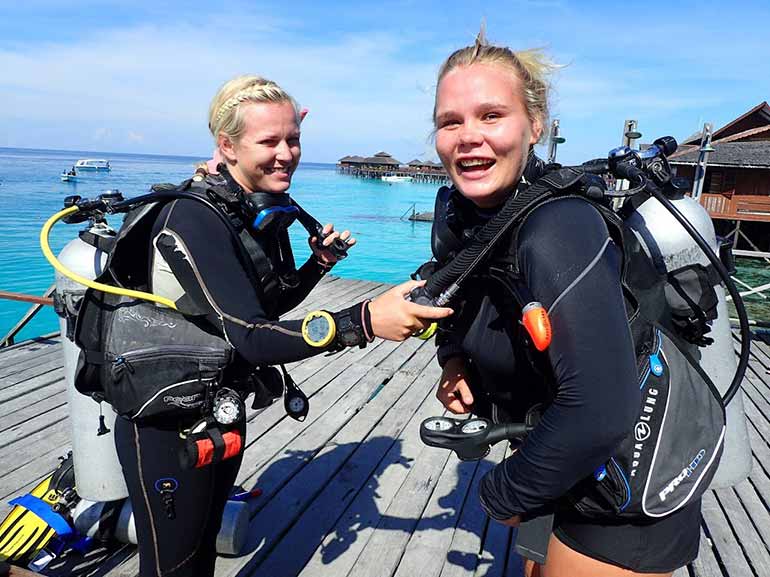
Here is a quick reminder on the meaning of BWRAF…
Check to ensure that everything is connected and functioning properly. Check that the low-pressure inflator hose is properly connected and that the buckles are securely fastened. Test the inflator button, as well as all of the deflate valves and releases, and make sure you can inflate the BCD orally (in case there are any issues with the power inflator underwater). Confirm that the tank is securely strapped in. Verify that all signaling devices are working and easily accessible.
Is your buddy wearing a weight belt or an integrated weight system? Check that the weight is correct and evenly distributed. Ensure that the weight pockets or belt are securely fastened and that either option allows for a quick release
The clips, straps, and buckles on your buddy’s BCD are also referred to as “releases.” Check ALL releases to ensure they are secure and properly adjusted, and instruct your buddy on how to open the release in an emergency. Don’t forget to double-check the tank strap and weight belt, in addition to the other releases. Check to see if there are any hoses or other items that could prevent a diver from exiting their equipment in an emergency.
Taking a quick breath or two off the regulator isn’t enough. You want to make sure that your buddy’s tank is fully opened and take multiple breaths while looking at an SPG. This allows you to ensure the tank valve is open, see how much air is available for the dive, verify the air monitoring device is functioning, and that the air tastes okay. Check you can breathe through the alternate air source and make sure it is correctly clipped off and visible so your buddy knows where to locate it in an emergency.
*We will need to adapt this during covid times.
Make a head to toe check to see if your buddy has everything they need (mask,snorkel,fins,computer, signal device and any specialized equipment which is needed for that dive). Secure loose hoses and other objects that may dangle and damage the reef. Check with your buddy if they are all right and ready to go!
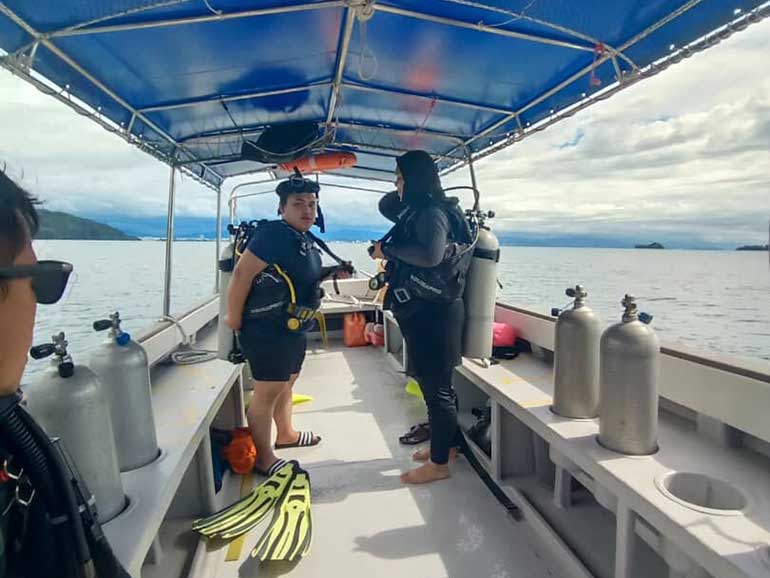
Mnemonics for BWRAF can be one of the more fun diving activities you can do above water! Your dive instructor would have probably given you a funny sentence to remember this (and some are definitely too rude to be shared online) Have a giggle exchanging all the ways to remember BWRAF!
Here are some of our favourites we have heard:
Do you have any other mnemonics to add to our collection? Let us know in the comment section!
Want to experience diving in different areas of Sabah? But not sure how to organise it or if you even have enough time? Don’t worry, we have you covered with our Sipadan – Kota Kinabalu Dive combo!
If you love the idea of extending city day trips diving with a resort stay, we have a fabulous new option for this now available in Sabah. We’ve teamed up with our Mabul Beach Resort to offer a full package with combined resort & day trips from the city, so you can get the most out of your diving adventure in this phenomenal destination.
You can choose from a number of combo packages or we can tailor one to your specific requirements.
A majority of visitors travel to KK to dive the renowned KK Marine Park (Tunku Abdul Rahman Marine Park), which includes the five incredible islands of Gaya, Sapi, Mamutik, Manukan, and Sulug. This well-known marine park has been around for almost 40 years, and Sabah Parks actively monitors and protects its marine biodiversity. As a result, this area is home to thousands of schooling fish, pristine coral reefs, unusual critters like sea horses, frogfish, and octopus, as well as Turtles, Black Tip Reef Sharks, Rays, and even Whale Sharks during the season. It is ideal for all levels of divers!
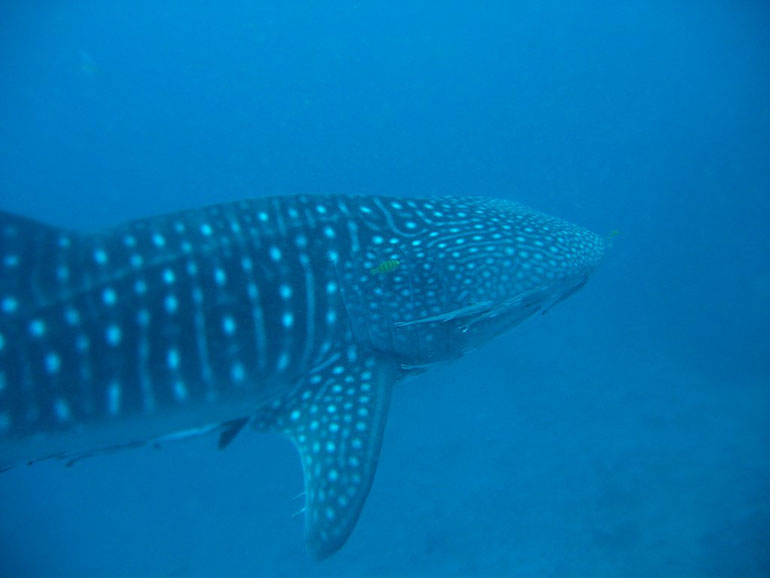
When passionate divers are asked to name their top dive destinations, Sipadan is typically at the top of the list. Sipadan is unquestionably one of the best dive destinations in the world, having been popularized by legendary sea explorer Jacques Cousteau. Today, the island drops over 2,000 meters to the seabed. Sipadan is located in the heart of the Indo-Pacific basin, which is home to some of the world’s most diverse marine ecosystems. The island is surrounded by strong currents, making it a meeting area for the entire marine food chain. This ecosystem is home to over 3,000 different fish species and hundreds of different coral species.
When you take a backward roll into the ocean, you’ll be amazed by the large number of green and hawksbill turtles. Sharks are also a virtual certainty, including whitetip reef sharks, grey reef sharks, and even hammerhead sharks if you’re lucky!
Schooling barracuda and big eye trevally often congregate in large numbers, creating a large tornado-like formation that is a once-in-a-lifetime experience, along with herds of bumphead parrot fish in the shallows. Let’s not forget about the macro-life; after spending some time looking at the wall, you’ll see nudibranchs, lobsters, octopus, and other interesting little creatures; there’s just so much to explore!
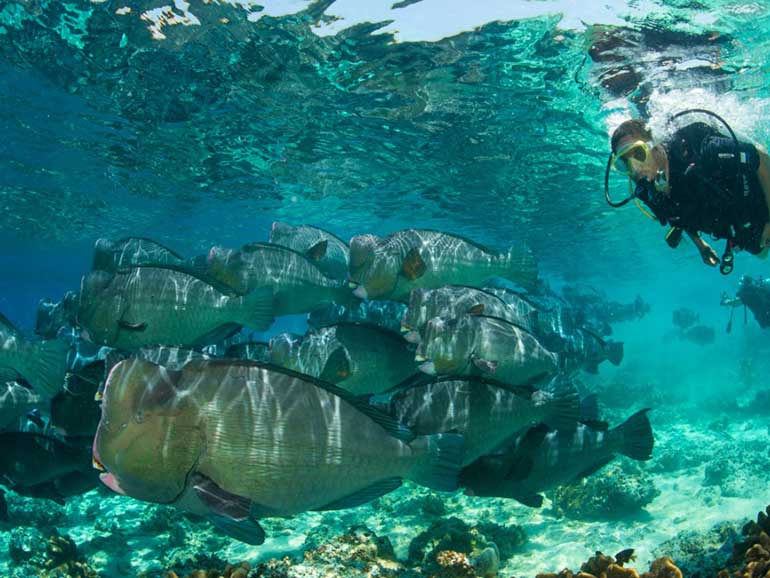
Scuba Junkie Mabul Beach Resort is an eco-friendly resort and strategically located on the beautiful Mabul island just a few steps away from some amazing shore dives on Mabul and a stone’s throw away from the incredible Sipadan island. With 30 en suite rooms situated on the beachfront, treat yourself to a little luxury at incredible rates. Our beautiful Mabul Beach Resort is the perfect base to explore Sipadan, Mabul and Kapalai.
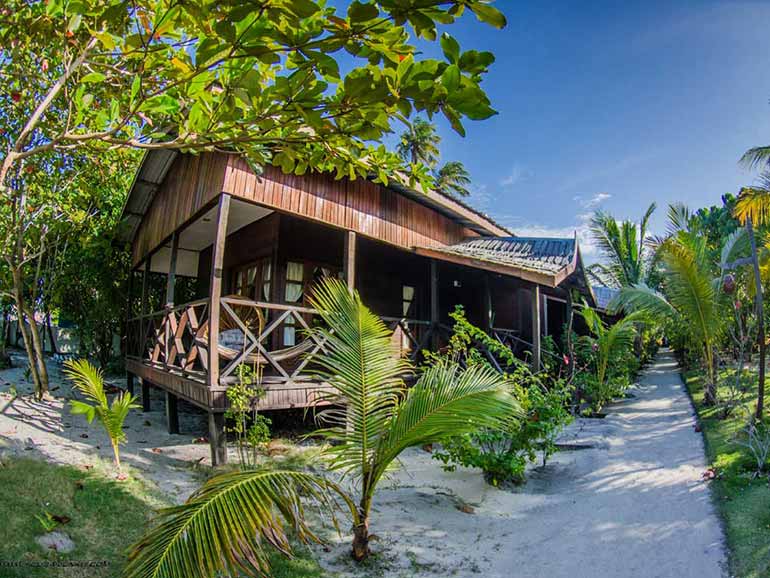
The best route to get from Kota Kinabalu to Mabul for your combo is to take a domestic flight with Air Asia or Malaysian Airlines from Kota Kinabalu to Tawau; there are a few options throughout the day, but you must arrive before 12pm to catch the 14:30 boat to Mabul. Alternatively you can do it the other way round, in this case you can catch the 10:30am boat back from Mabul and choose a flight anytime from 3pm onwards to Kota Kinabalu.
The package options are flexible, but to get the most out of your visit you can check out our examples that work best with transferring between both locations quickly and efficiently so you don’t waste extra time travelling, when you could be diving. We can’t wait to welcome you at both locations!
As a fellow diver I’m sure many of you have heard about night dives before. Have you guys ever tried it? If not, then continue to read below for reasons why you should try night dive at least once in your life.
We all know that diving is a very exciting activity, but night dive is something that is even more thrilling! As we dive deeper during the day, it’s harder for us to differentiate the real colour of the object that we see. You won’t have this problem during night dive! With the help of the light from your torchlight, you are able to see the true colour of those marine life. Corals & fish that look amazing at daytime is even more dazzling at night. Many underwater photographers especially love night dives as torchlight can keep most of the colour spectrum. This makes the photos appear to be more vibrant & colourful.
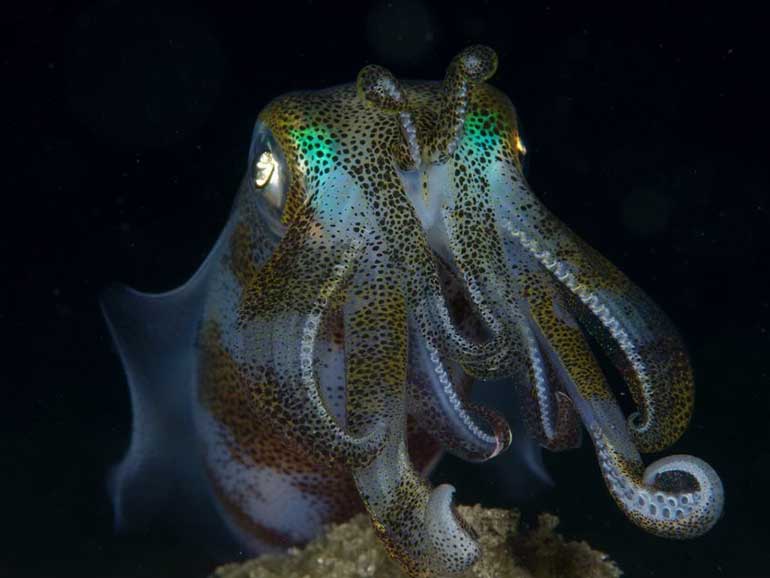
One of the reasons that attract divers to go for night dives is the bioluminescence phenomenon. As the water turns inky dark, you will have to rely on your torch to see your surroundings. However, you will need a dark environment to be ab to spot these luminous planktons. To see it, all you need to do is cover up your torchlight by simply pointing towards your chest & wave your arm around the water. You will then feel like you are in the bioluminescent scene of the movie Avatar! We do it during the safety stop time so you will have a magical experience to end your dive!
Night dives will definitely change your perspective of the underwater world. They allow you to see the marine life that are hidden during the day time. For example, many shrimps, crabs & lobsters will show up at night. It’s hard to see this marine life in day time as they are almost stay hidden in a camouflage environment. This makes diver hard to spot them. They will become active at night & will come out from their hidden place to hunt. You might even be lucky enough to see sharks passing by. Seeing a shark at night is definitely more exciting than in day time!
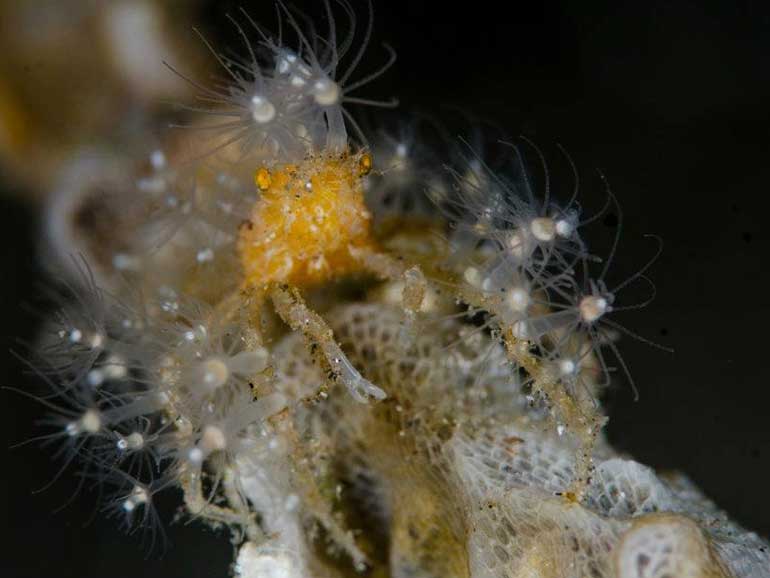
One of the difference between day dive & night dive is the equipment. Doing a night dive means that you will need a torchlight to give you the additional light to see the underwater world better. You will need to rely heavily on the torchlight to see everything around you. Using a torchlight is definitely something that is unusual for most of the divers as we rarely use it for day dive. So a night dive will give you the chance to use it & see all the sea creatures using artificial light. Torchlight is very crucial during night dive. You can only get attention from your buddy & show hand signal using the torchlight in the pitch black water.
During the night, some animals behave differently. Stingrays and sharks prefer to hunt at night, despite the fact that they can be seen during the day. But it’s not just them. The coral opens its polyps to feed, lobsters emerge from their hiding places in search of food, and octopi swim freely. In other words, a night dive provides an opportunity to observe the food chain in action.
Night diving is a very exciting journey as everything changes at night. The part of water where you go diving regularly may look completely different to you when you go for a night dive. The only light that you get when doing a night dive is the one from your torch. So you will be become very focused on what’s right in front of you only. As you can rarely see those big stuff at night so you turn your attention to macro that you might missed during day dive.
Night diving can be intimidating for divers, it’s an activity that challenges divers outside of their comfort zone, but the sense of accomplishment that you feel right after finishing a night dive is beyond measurable!
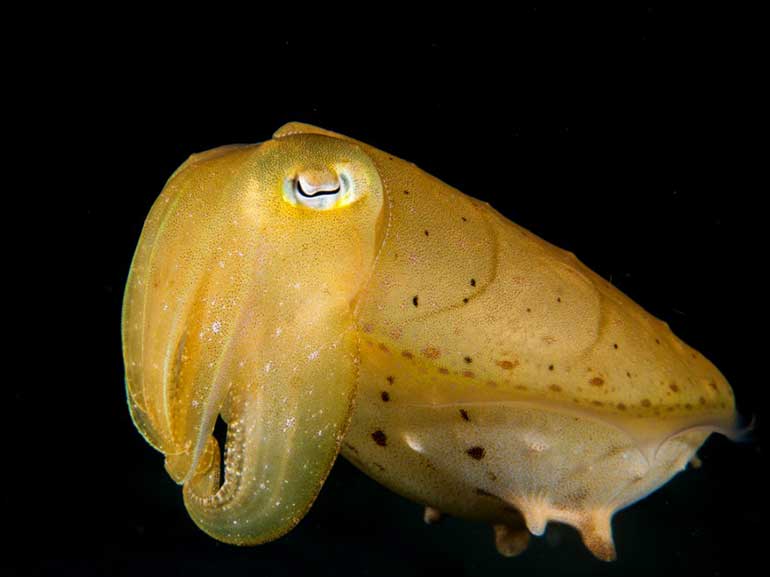
Night diving can be a breathtaking and fascinating experience. So, what’s holding you back? Try this adventure if you want to rediscover your love of scuba diving!
The best way to observe a fish is to become a fish.
Jacques Cousteau
Since humans are not natural aquatic creatures, we aren’t able to see, stay or breathe underwater. Therefore, the best way to get to know the underwater world is to immerse ourselves in it by becoming scuba divers. There are 3 components to becoming a competent scuba diver; adequate knowledge, fundamental skills, and a good set of equipment. Let’s look further at diving equipment.
Our eyes aren’t capable of seeing clearly underwater due to the refraction of light through substances of different densities. This is why things look all blurry when we try to open our eyes underwater. We need to wear a mask to solve this problem. The air inside our mask allows our eyes to focus and see things clearly underwater. A snorkel on the other hand comes in handy if we ever need to swim face down on the surface of the water.
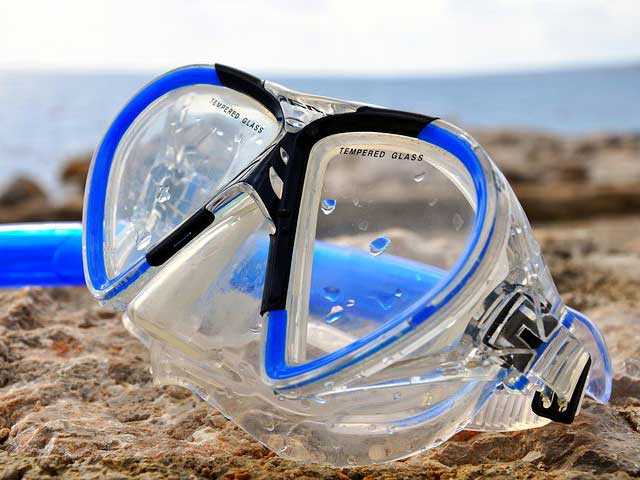
Fins are another important part of our diving equipment because fins help us move easily through the water without wasting too much energy. Fins are generally split into two types; open heel and full foot fins. Open heel fins are more commonly used in colder waters as we would normally be wearing booties (diving boots) with them to keep our feet warm. Open heel fins have straps to secure our feet. Full foot fins on the other hand completely cover our feet and are usually used in warmer waters.
When diving we usually wear a wetsuit or a dry suit depending on the temperature. Wetsuits are used in warmer waters. Wetsuits are normally made of neoprene and fit snugly. It helps us keep our bodies warm by restricting the movement of water in and out of our wetsuits. Drysuits on the other hand are used in colder waters and are loose-fitted with rubber seals around the neck, wrists and ankles to restrict water from getting in and getting in contact with our bodies. It works by insulating our bodies with air instead of water. This drastically reduces heat loss from our bodies.
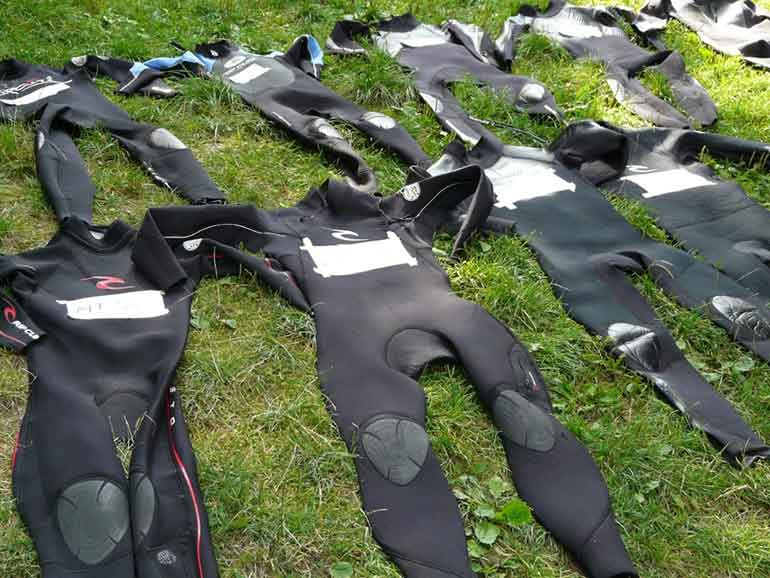
Our regulator is what allows us to breathe underwater. It has a first stage that is connected to our scuba tanks. The first stage regulates the high-pressure air in the scuba tank by lowering it. The other part of the regulator is called the second stage that is inserted into our mouths for us to breathe from. This second stage further regulates the air pressure and allows us to comfortably breathe the air underwater. The most important function of our regulator is how easy it is to breathe from.
Scuba tanks are what store the air we use to breathe. It is generally made of aluminum or steel. It is capable of storing large amounts of air. It comes in various sizes and styles. How long a tank lasts on a dive varies from person to person as it all depends on how efficient we swim (energy saving) and breathe.

Our depth gauge uses the surrounding water pressure to indicate how deep we are and also what the maximum depth we reached on our dive was. Having this information is key to staying well within our diving limits keeping us safe. Our submersible pressure gauge on the other hand is connected to our regulator first stage attached to the scuba tank and tells us how much air we have left in our scuba tank. This ensures that we can end our dives before our air supply gets too low.
As the name suggests, this device controls our buoyancy. It comes in various sizes, brands and styles. Some styles are like a jacket or backpack. It is important to be comfortable with the BCD we are using. How it works is that it is strapped to the scuba tank and connected to the first stage of our regulator via a low-pressure inflator hose to allow us to inflate air into our BCDs from our tank. Inflating enough air into our BCD allow us to float while we are at the surface, when beginning a dive we release air from it to sink and adding small amounts of air into our BCD to control our buoyancy while diving.
There are various styles and brands of dive computers. Some have more functions than others. A dive computers main function is to show us our dive time (how long we’ve been underwater since the start of our current dive), the current depth we are at, and how long we can safely stay at the depth we are at. Other functions that dive computers have based on the type are air supply (how much air we have left in our scuba tanks), digital compass, dive profiles, conservancy settings. A prudent scuba diver monitors their dive computer and makes sure they dive within safe limits!
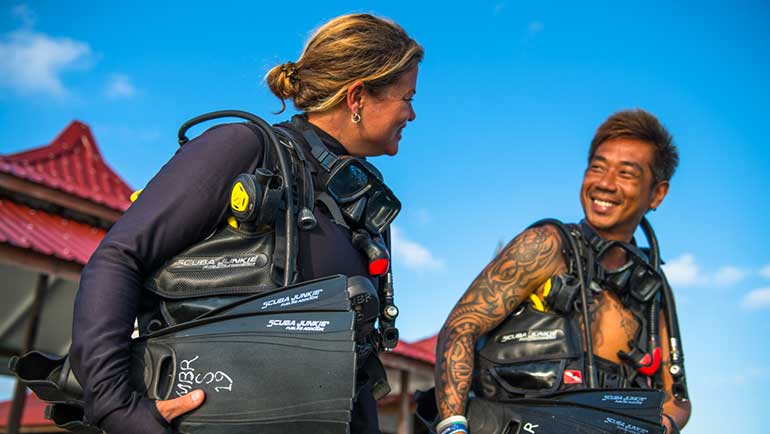
Blacktip reef sharks are frequently seen when diving in Kota Kinabalu, particularly around Gaya and Mamutik Islands within the KK marine park. They mostly prefer shallow, inshore waters where they feed upon small fish, squid, and crustaceans, which is great as divers don’t have to go too deep to see them and even snorkelers can get the magical experience to see them. The Blacktip reef shark is a docile and inquisitive shark species, so if you ever wanted to snorkel with sharks then this is a great opportunity!
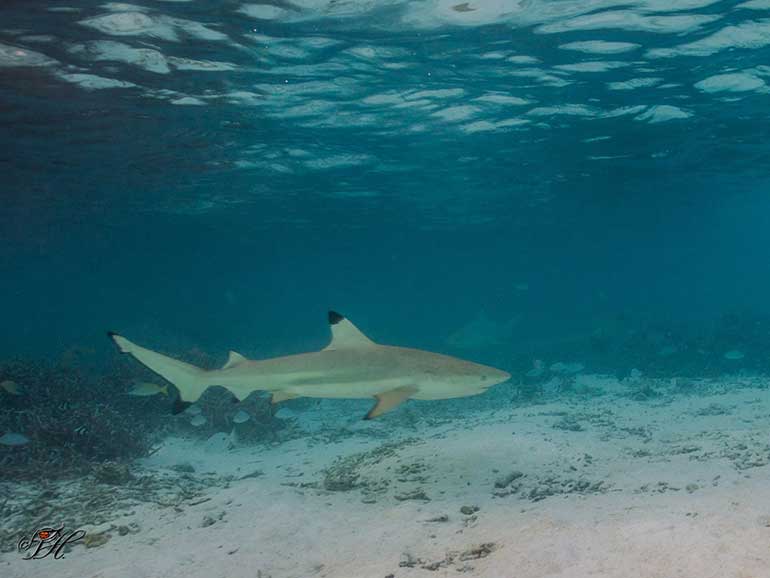
The Blacktip reef shark has a sleek grey-coloured body, rounded snout, horizontal eyes, and tell-tale attractive black tips on all of its fins. Despite their mouth full of serrated teeth, they are known to be docile and timid around humans, so there is nothing to worry about being around these guys!
Size-wise, the blacktip reef shark is a small to medium-sized shark. They can grow to be up to 2 meters long and weigh between 60 and 100kg.
Blacktip reef sharks can live for more than ten years and reach maturity at the age of four to five years.
While most sharks are solo hunters, blacktip reef sharks are often seen traveling in small groups which is helpful for more effective results hunting their prey. Their diet consists of fish, which are abundant around the coral reefs, crustaceans and have even been seen hunting rays! They are extremely fast and skilled predators which normally hunt at night.
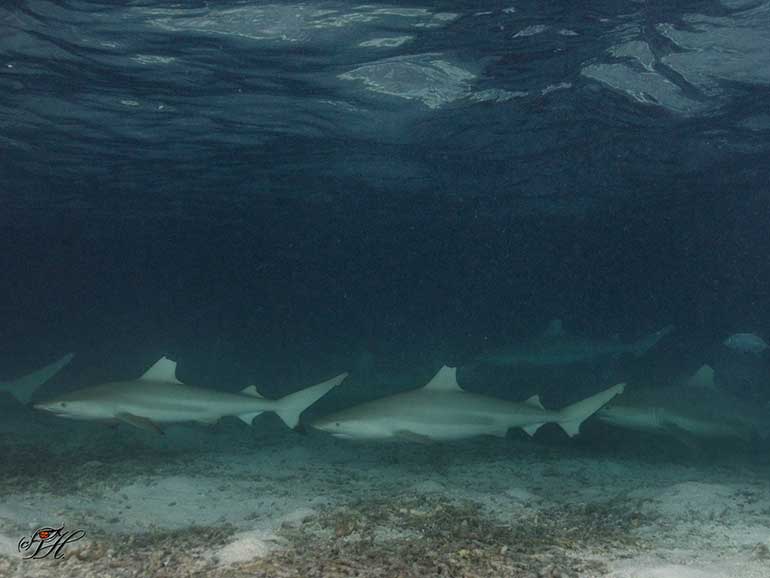
Blacktip reef sharks are viviparous sharks, which means they give birth to live pups instead of eggs. Their gestation period is believed to be around 10-12 months, giving birth to an average of four or five pups per litter. Courtship involves one or more males trailing closely behind a female. Reproductive behavior consists of distinct pairing with an embrace, in which the male grasps the female’s pectoral fin between his teeth and mates belly to belly. Females rest for 8-14 months between pregnancies to rebuild their energy stores.
They can be found all across the world’s oceans. They prefer shallow waters to deep oceans, and can frequently be seen at depths of less than one metre. The preferred habitat for blacktip reef sharks is around coral reefs with clean and warm water, as well as nooks and crannies to hide in. They are quite often seen hanging out in groups.
The blacktip reef shark offers a wonderful opportunity to get up close to safe sharks, they are a very peaceful, non-aggressive species. So leave your fears at home, pack your gear, and jump in to get to know this beautiful shark species here in Kota Kinabalu.
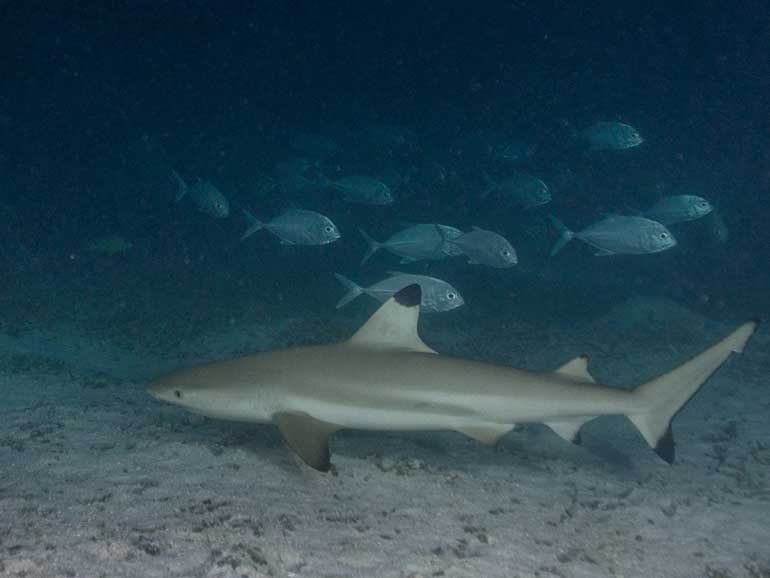
We’ve all got them. Those friends who, come summer, can always be found in their swimsuits by the sea, soaking up the sun’s rays or, more likely, swimming in the ocean waves.
So, the next time you’re looking for a gift for the water lovers in your life, consider giving a snorkeling or scuba diving gift voucher. There are endless underwater adventures to be had, whether you prefer to glide across the water’s surface and snorkel or breathe underwater with a scuba diving experience.
The beauty of experiences is that they are not disposable. You can continue to participate in the experience after you finish it, or you may never do it again, but the memories you make will stay with you for the rest of your life. Ask any diver and they’ll tell you exactly what their first breath underwater felt like.
We offer a vast array of snorkeling and diving gift experiences that will be sure to leave a lasting memory for whoever you choose to gift it to.

For those who prefer calmer waters or are a little nervous about what lies beneath the surface, a snorkeling gift is the ideal way to get a taste of life under the sea. Snorkeling is suitable for beginners and takes place in clear, shallow water, allowing for free exploration of the ocean floor as snorkelers float on the surface of the water. After putting on the gear provided they will be ready to explore the ocean floor!
Snorkeling is a great way to explore the stunning coral reefs found in the world’s tropical oceans. Snorkelers will be in for a treat as they swim among beautiful tropical marine life surrounded by colorful coral and pristine turquoise water. They will have the chance to see lots of colourful reef fish, Turtles and even a possible sighting of Black Tip reef sharks! But don’t worry they are super chilled and just swim past you not even noticing you are there.
A snorkeling experience is the ideal way to introduce your ocean-loving friends and family to the underwater world from the surface of the water.

A scuba diving gift is ideal for those who are a little more daring and want to breathe underwater. A diving gift will allow your recipient to truly explore the depths of the deep blue, making them feel like one of the marine life! Even better, we have a wide selection of diving gifts, allowing anyone, regardless of experience level, to explore the ocean.
We provide an introductory diving experience (Discover Scuba Diving) that is ideal for beginners and is sure to instill a lifelong love of adventure in the sea! For those who want to take their diving hobby to the next level, consider gifting a certified diver course, of which we have many to offer! And once certified, the number of underwater adventures to be had are vast, with endless options to choose from. No matter which gift you choose, your recipient will return to shore with an unforgettable memory.

If you don’t have the funds to give an entire course to your friend or loved one you still have a couple of options! Consider going in on a joint gift with a few other friends or family members and split the cost. Don’t have anyone interested in going in on the gift with you? How about gifting a money voucher towards the diving experience.
So, no matter how you do it, give the gift that will continue to give for years to come. Give the gift of scuba diving and change someone’s life!
“Happiness doesn’t come from the things you own, it comes from things you do and the people who share your adventures”
PADI
Kota Kinabalu is a perfect dive location for those who love macro! The diving here is very easy & you won’t need to go too deep to search different species of macro. Have you ever wondered what macro critters we have here? We have listed down 5 fascinating macro critters you can find diving off Kota Kinabalu.
Frogfish can be found when diving at the Tunku Abdul Rahman Park. They are considered one of the strangest looking fish in the water, however, they are also a master in hiding underwater. They camouflage themselves very well & are very good at adapting to their surroundings. They are able to hide from predators using their amazing disguise ability. Frogfish come in different shapes, colours & skin textures according to the surrounding environments that they live in. Some even resemble the coral or rock so very much that you won’t be able to tell the difference! Their amazing chameleon-like camouflage ability is useful when it comes to hunting. The potential prey like small fish will just swim past them without noticing the well-hidden frogfish until it’s too late.
As for divers, you will need to have a pair of eagle eyes to spot them! Having a dive guide who is familiar with the surrounding sea condition will come in handy in this situation. It is definitely a treat to be able to see frogfish underwater. The colour of frogfish can be varied throughout their lifecycle. Frogfish have contrasting colour, together with their weird-looking face, it makes them one of the popular photography subject for divers.
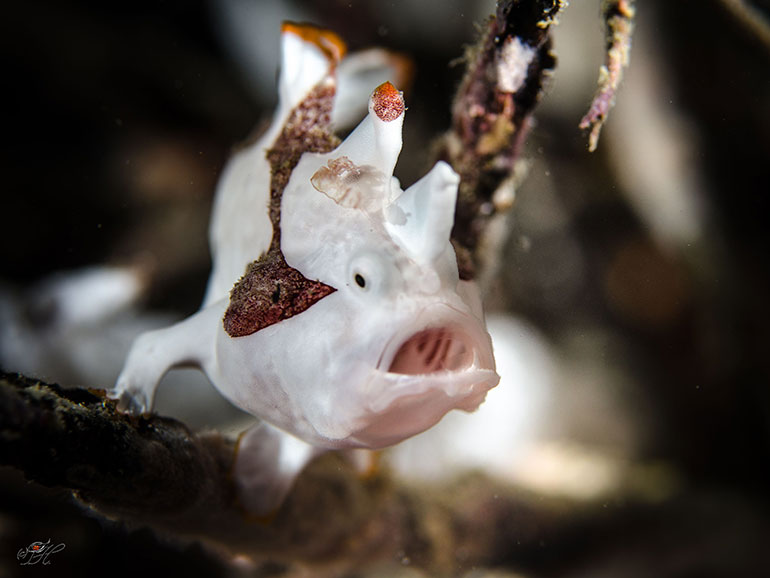
Blue-ringed octopus are small in size, however, they are definitely not as harmless as they look! This tiny creature can even fit into the palm of a human hand, but the venom that they carry is enough to kill a human and until now, there is no antidote for it. It is considered one of the most dangerous animals in the ocean. The blue-ringed octopus gets its name from the bright blue rings that appear when they are threatened.
Although the blue-ringed octopus is venomous, there have been very few reports of divers being bitten by them. They are usually hidden away in the morning and awake at night. It is perfectly safe to dive with them as long as you don’t go and provoke them. We often find them hidden among coral reefs, small stones & sandy bottoms.
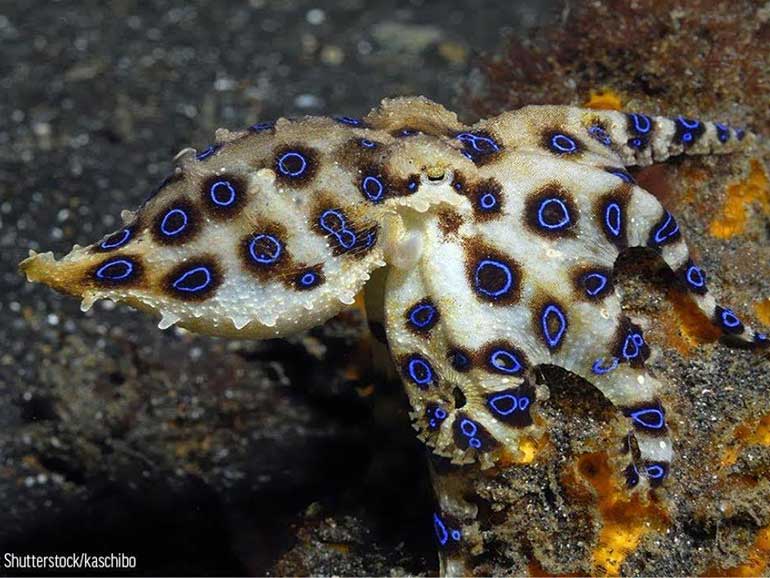
The islands around Kota Kinabalu city are definitely some of the best spots for those who are nudibranch lovers! We can find many different types of nudibranch when diving around here.
Nudibranchs are one of the most sought-after subjects for underwater photography. This is because nudibranchs have very vibrant colours and come in different unique shapes. They move very slowly through the water however you often see them stationary, so divers have more time to photograph their beautiful side from the best angle. There are even some divers who head out to dive especially to find nudibranchs so that they can take pictures of them, and add into their collection!
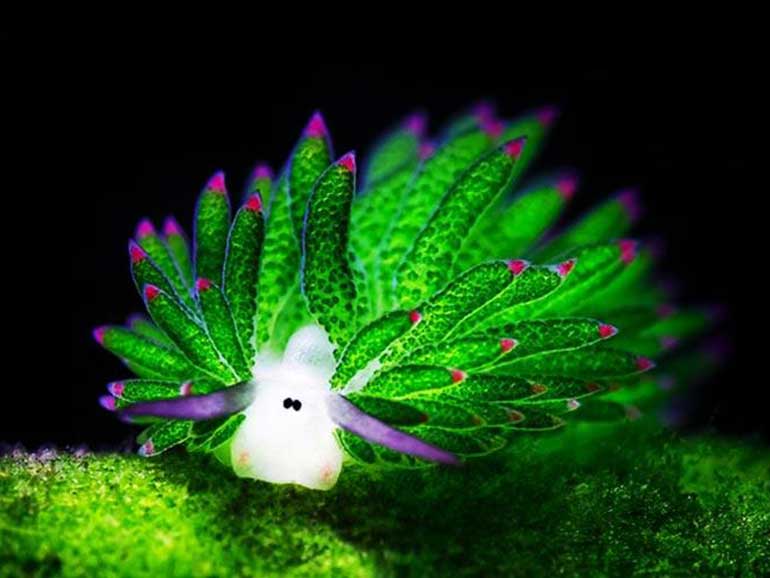
When it comes to what creature is the hardest to spot, the seahorse is surely on the list! The types of seahorse that we find here are generally very tiny. Spotting a seahorse is like playing a searching game underwater. Seahorses live in shallow areas and often in seagrass beds.
Seahorses have a very unique appearance, they have a horselike head, prehensile tail, independently moving eyes, and brood pouch. As they are not very good swimmers, divers are still able to get that perfect shot of them even when they are super small.
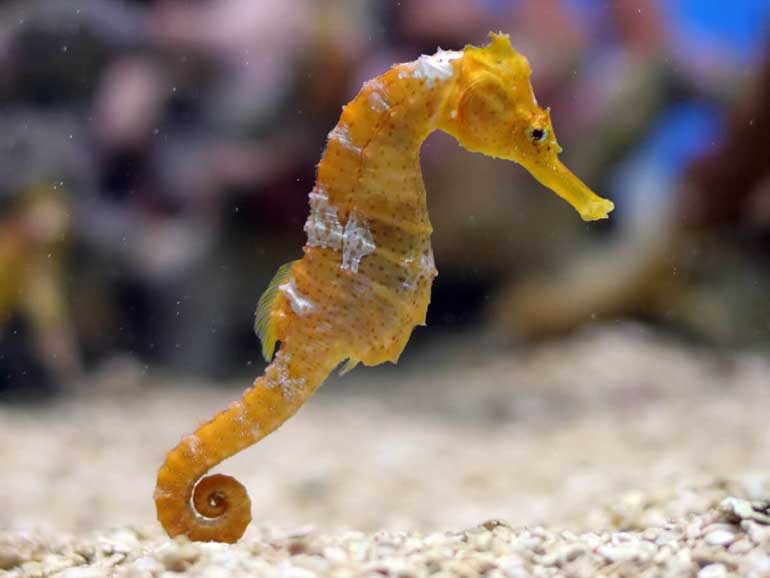
The cuttlefish is another macro critter that you can see when diving at Kota Kinabalu. Cuttlefish will release a cloud of ink when they feel threatened, which gives them some time to escape. Besides, cuttlefish is another king of camouflage. They often bury themselves into the sandy bottom, leaving only their eyes exposed. Other than that, cuttlefish can change colour too according to their surroundings, which makes it harder for us to find it! You can easily miss them if you are not being cautious. But no worries, our expert dive guides will show you exactly where to find them when you are diving with us.

Do you want to explore the macro diving around Kota Kinabalu? Contact us today!
You’re planning your next holiday and want to squeeze in as much diving around the area as you can. Borneo itself being one of the top dive destinations in the world and you start reading reviews on dive centres and dive sites. Comments you see floating around being “hitting my personal max depth record of 29.7 metres!”, “definitely have your advance before coming here!”, “Eagle rays swam past at 25metres!”, “frogfish at 28metres!”. You have an open water diving license and definitely want to get the most of your diving holiday. So you think to yourself, maybe it’s time I get my advanced open water certification.
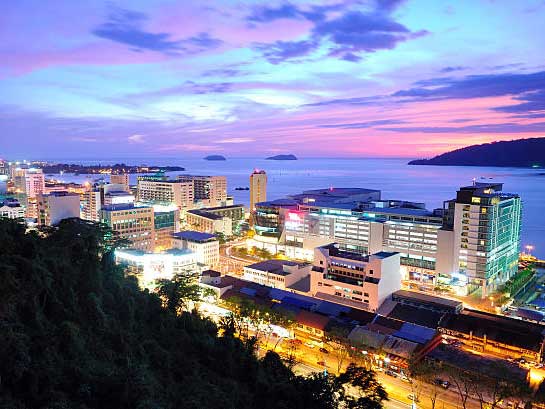
Kota Kinabalu is the capital of Sabah (North Borneo). It has an international airport that is 10 minutes away from the city centre. Your dive sites are only 15 minutes away by boat from town. First-world amenities at your doorstep and 5-star hotels within a 10-minute drive to the jetty to head out for a day of diving. There’s no other place on earth with this quality of diving so close to the city centre.
In Kota Kinabalu, almost all dive centres are mainland-based. This means you can book your dive courses without having to worry about inflated dive resort prices but still get your certification from a top-rated dive centre that maintains high standards in training its student divers. Choices of accommodation from cost-effective backpackers to 5-star resorts are abundantly available within 10 minutes from the meeting point/most local dive shops. This is one of the cheapest places to get a proper diving certification.
Kota Kinabalu is known and ideal for doing any course because of its calm waters and mild to none currents. This makes doing advanced open water dives such as peak performance buoyancy or underwater navigation a lot better because you’re focused fully on the skills at hand and not being dragged away by currents. It is also ideal for doing the course’s deep dive as most of the sites are sandy at 30 metres. You can rest assured and be comfortable completing the tasks during the deep dive without worrying about damaging corals or hurting yourself.
Plenty of the dive centres in Kota Kinabalu are attached to or have branches in other areas. Some even in other countries. This allows you to get first-hand information on deals and special promotions being given, with possible discounts! Most of the dive staff have worked in other areas as well and can give you their personal opinion on where the best diving is and dive centres they feel give you the best service, value for money and are environmentally conscious.
Enrolling in a course in Kota Kinabalu is so easy. Dive shops are in town and the jetty is a 10-minute walk from the dive shop. Even if diving wasn’t on your list of things to do, you can easily squeeze in an advanced open water course in between your activities as Kota Kinabalu is generally the base for most travelers. Ideal for the last-minute backpacker/planner, all you do is show up, make a booking, and do 2 days of diving the following days (or days of your choice) without any extensive travelling from your base. It doesn’t get any easier than that!
What are you waiting for? Time to get that advanced open water certification with Scuba Junkie KK. Contact us today!
We often get asked ‘when can my child start to dive?’ Well there is actually only one age restriction, you can begin your diving experience at 8 years old & there is no maximum age. It is a great activity to do together as a family!
As a diver who is completely fascinated with the underwater world, you want your children to learn to dive as soon as possible. It’s understandable that you are excited to show them the wonders of the sea, diving among stunning marine life, and discovering the colourful coral reefs with them. However, you are aware that it is critical to learn diving properly in order to do all of these things in a safe and fun way.
From the age of 8 PADI offers two options for your children: The Bubblemaker program and The Seal Team Program.
The Bubblemaker program introduces participants to the emotions associated with diving and breathing underwater. Your children will have the opportunity to learn some basic scuba diving principles in a pool or confined water with a maximum depth of 6 feet/ 2 meters through this course.
The Seal Team program provides a more in-depth confined water experience. Your children will learn basic scuba diving skills while they have fun taking underwater photos, practicing buoyancy, and learning environmental awareness.
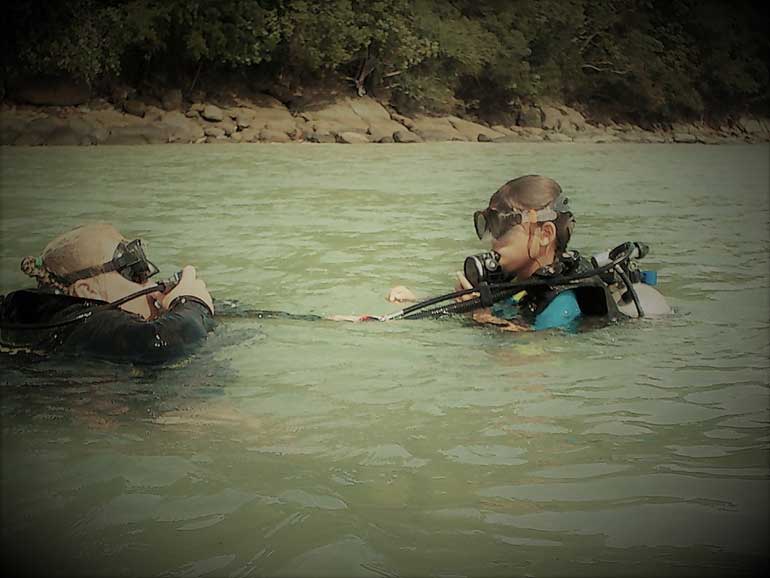
You will have to wait until your child is 10 before they can explore the ocean a bit more. At this age they are now old enough to participate in the Junior PADI Open water course. It is similar to the adult certification program but with smaller teacher-to-student ratios and shallower depth limits. To enroll, kids must be age 10 onwards and be able to swim comfortably.
If they would like to experience a try dive first in the ocean then they can have a day doing the PADI Discover Scuba Diving. This allows you to experience the thrill of diving in confined water under the supervision of a PADI Professional in simple conditions. During this adventure, you will learn some fundamental concepts and great skills and will even head off to try an open water dive!
Many scuba instructors say that children are often more ready and eager to learn to scuba dive than adults! In addition to providing them with outdoor exercise, scuba diving makes children more aware of marine life and helps them develop environmental awareness.
A child who wishes to dive should be medically fit for scuba as should anyone else, please check out our “fit to dive” questionnaire. They should also be eager to learn and comfortable in the water.
After receiving a Junior Open Water certification, divers 12 and older may continue to gain experience and explore deeper depths by enrolling in Jr. Adventure Diver, Jr. Advanced Open Water, Jr. Rescue Diver or one of many PADI specialty courses!
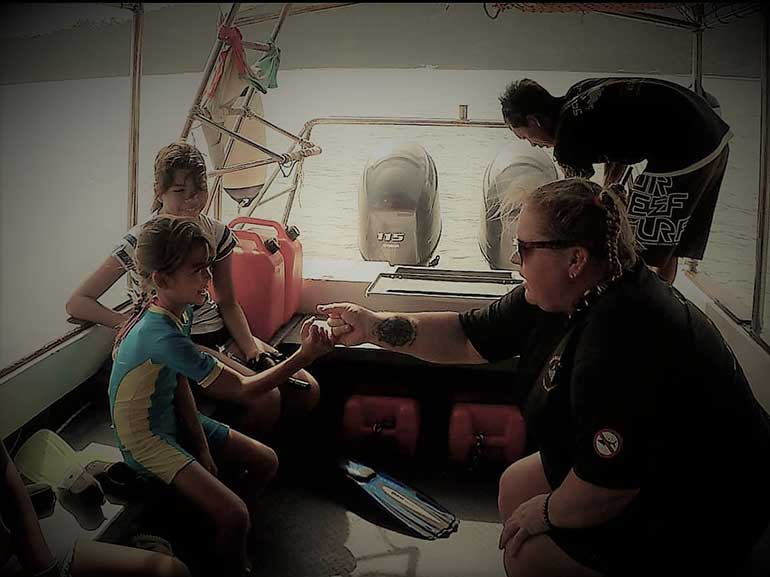
You are never too old to dive! Contrary to what a lot of people believe, generally, scuba is not a sport that demands a high physical effort. That is the reason why there is no scuba age restriction at all to practice it, as long as you are medically fit & the doctor approves you to dive you are ready to go!
The pros for early learning are definitely there as it will build a child’s confidence in the water and exploring new places. Diving will increase their awareness of the ecosystem and how to help the natural world. As well as spending time with you, diving will teach kids responsibility and real-world applications of physics, biology, and maths if done correctly. We would love to welcome you and your family to start your dive education with us here at Scuba Junkie & become part of our SJ family!
So you’ve taken a leap of faith and signed yourself up for your first ever day of scuba diving (Discover scuba). After years of watching movies and TV shows, seeing the underwater world and the life that belongs to it, you decide its time for you to be a part it.
Morning comes and you’re on a Scuba Junkie boat heading to the islands. You look around and see clear, calm turquoise coloured waters. On reaching one of the tropical islands around Kota Kinabalu, your scuba diving instructor starts his briefing. There you will learn the basic fundamentals of scuba diving, which are;
Before you know it, you’ve got your equipment strapped on, sitting on the edge of the boat preparing to roll backwards into the water like James Bond. You’re nervous but slowly rollback and land in the water and float up feeling like you were just on a roller coaster. You start your short swim to the shore getting to shallow water. You reach waters around chest level and your instructor briefs you on what’s going to happen. You kneel down and see this whole new world you’ve entered into.
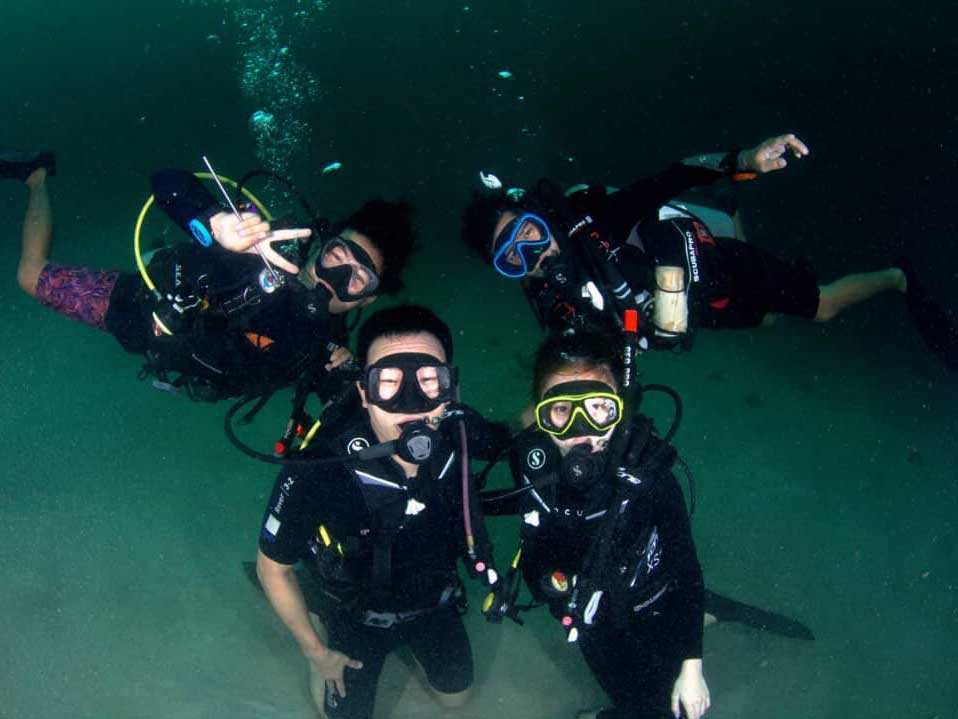
First few breaths underwater feel odd, breathing entirely through your mouth feels strange but okay. Skill session starts and you see your instructor demonstrating a skill, regulator comes out of mouth and back in, and exhale. Seems simple. You try it and you complete it with ease. You then complete a few more skills and your instructor says it’s time to go see the underwater world.
You slowly swim out to the slope and your ears feel uncomfortable, you see your instructor looking at you and pinching his nose and making a blowing motion, then you remember. You pinch and blow gently from your nose and the discomfort goes away. You continue diving along the sand, seeing damsel fish hanging around picking fights with other fish. Move along a little more and see a blue spotted stingray emerging almost slow-motion-like from under the sand flapping its wings and gracefully gliding away. Not forgetting the lovable clown fish(nemo), ever so fierce in protecting their home. First session is mostly over sand and bits of coral to get used to swimming underwater. Your instructor gives you a thumbs up indicating it’s time to head up to the surface and take a break.
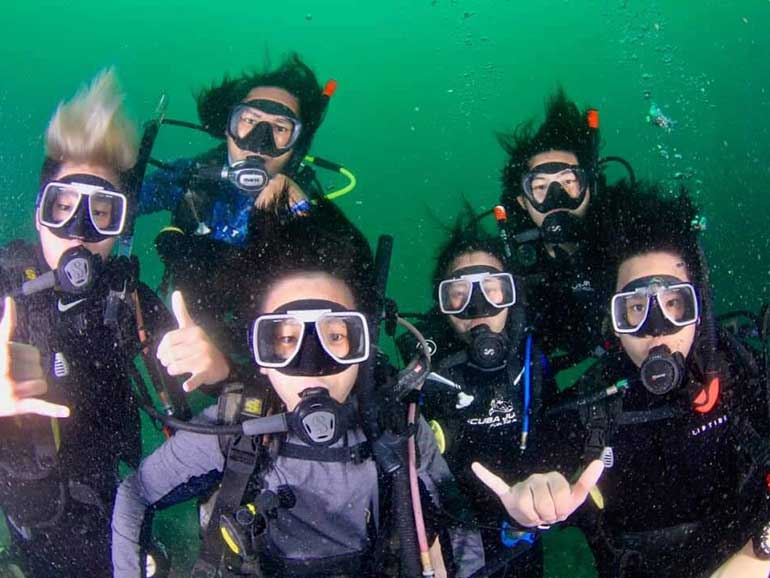
After a break on land and chatting away with the other divers, it’s time to get back into the water. This time your instructor says we’ll be mostly over coral for the whole dive and to watch your fins and stay well above the corals. Corals are fragile and break easily. Your boat takes you out to the back of one of the islands, you look out and see the coral reef right under the boat. You do your back roll like a pro and swim towards your instructor. You and the gang drop over the sand right beside the coral reef, readying yourselves in preparation for your amazing dive. Onto the coral reef and there’s just so much life! Colourful feather stars on corals, blue sea stars, groups of hundreds of fusiliers coming down from midwater onto the reef. The lazy grouper chilling on a coral and swimming away as you get close. A turtle swimming by coming to check out the new kid on the block. Who would not fall in love with such a world!
What are you waiting for? 😉